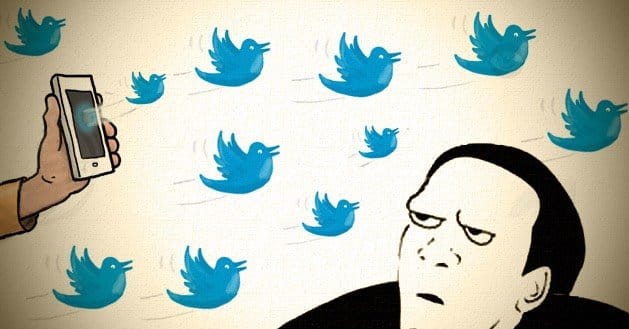 Written by ContentPowered.com
Written by ContentPowered.com
Twitter can be very valuable for business marketing. Unfortunately, that’s common knowledge. It seems as though every business under the sun is scrambling to establish a Twitter audience and promote whatever it is they’re selling. This has clogged the usual Twitter channels and made it harder on everyone to succeed. What used to be the standard for success is now the bare minimum to even be noticed. To truly succeed with Twitter, you need to be very careful with how you use the platform.
If your tweets aren’t engaging users and getting them to interact and click through, you’re doing something wrong. The only question is, what?
You Time Them Wrong
Twitter is a platform all about the immediate response. When an event happens, the first few people to tweet about it are the people who guide the way the conversation begins. Often, these people are the ones who earn all the exposure, as their tweets are retweeted to add commentary. If you’re not the one starting the bandwagon, you’ll have to be one of the many people jumping on later, which earns you far less engagement unless you have something truly interesting or insightful to add. Essentially, the longer you wait, the more you have to contribute to be noticed and engaged.
Timing is also important when it comes to the scheduling of your tweets and the availability of your audience. You need to pay attention to the active times of your audience. What time of day are they most active? What day of the week? Is the peak for activity different from the peak of engagement?
Armed with this knowledge, you want to schedule your posts to show up right when your users are browsing their tweets. The closer to the top of the feed your content happens to be, the more likely it us you’ll receive engagement from your users.
You Post Too Frequently
Now, none of that means you should load all of your tweets into one short time frame. In fact, quite the opposite. You can measure that, the more you tweet in a given time frame, the worse your engagement will be past a certain point.
That certain point is the important part. Tweeting once an hour isn’t enough to win you the Twitter presence you need. Tweeting 25 times in an hour is going to flood your users with nothing but your smiling face and/or business logo, and they’re going to grow sick of seeing you.
You need to strike the right balance of frequency and activity. You also need to consider the times when you aren’t active. Social media managing software allows you to schedule tweets to land in the future; make use of this feature.
You never want to schedule your most important tweets to post at a time when you’re not available. Rather, use scheduling for retweets of content you want to share but don’t want taking up your peak hours. Use scheduling to post comments that don’t have a time-sensitive nature to them. Important tweets that you really want the most possible engagement on should be posted when you’re available and active.
You Never Reply
The reason is this. You need to be available and active when you post the tweets you want to engage users with. If a user responds to your tweet asking you a question, and you don’t respond for six hours, the value of using Twitter as an immediate social media connection disappears. Twitter users are used to the immediate, the reactive, the proactive and the instant. If they send you a message, they expect a reply quickly, not the next day. If they wanted a response the next day, they would send the message to your Facebook page or your contact email address.
The key that many businesses fail to realize is that user engagement is a two way street. You can’t passively throw out tweets and assume engagement will follow. You need to be around to response and reply. You need to interact. You need to be social on this social media platform.
You’re Saying Nothing New
Another common problem that causes businesses to fail engagement through Twitter is the lack of originality. Users on Twitter are not afraid to ignore you if you’re giving them nothing of value on their feeds. If all you do is retweet something the industry leaders in your niche say, your users will just ask themselves why they don’t follow that leader instead. It’s worse if you try to hide it by posting your own “opinions” when all you have to say is the same as what others have said before you. You’re essentially standing up just to say “me too!” and hoping it sticks.
If you want true, deep user engagement, you need to dig into the issues and think critically about them. More importantly, you need to post your insights, not the regurgitated opinions of other niche blogs.
You Targeted the Wrong Audience
Another common flaw with social media users is the desire to have a large audience over the drive to have a focused audience. Think about it for a moment. Which is better?
- An audience of a million followers who almost never retweet, comment or mention your business.
- An audience of 50,000 followers who are frequently retweeting your content, adding their own insights and asking you for advice.
The first one has one benefit and one benefit only; the number is larger. Unfortunately, that’s not much of a benefit at all. You can inflate that number by going to Fiverr and spending $5 for 1,000 twitter followers; those followers aren’t going to do anything for you. They don’t make your page look more legitimate. In fact, savvy users will see you have thousands of followers but very little in the way of interaction and will wonder what’s wrong.
You need to make use of analytics and targeting to make sure your audience is actually interested in your business and your posts. That way they are more likely to spread your tweets around and interact with you through the platform.
You’re Too Promotional
Twitter is not an advertising platform. It’s not a web commercial. It’s not the equivalent of newspaper classified; that’s Craigslist. What too many businesses miss is the true purpose of using Twitter; to build trust and reputation.
The point of using Twitter is to make your audience consider you an authority figure, someone they can trust to do the research and form valid opinions. Once they trust you, then you can try to sell your products or services. If your Twitter feed is full of nothing but promotional announcements, you’re not engaging your users, you’re trying to sell to them. It just doesn’t work. Twitter users have a very low tolerance for that kind of promotion, and are not shy about unfollowing you. Cut back in the promotional language and you’ll have a better chance at success.





